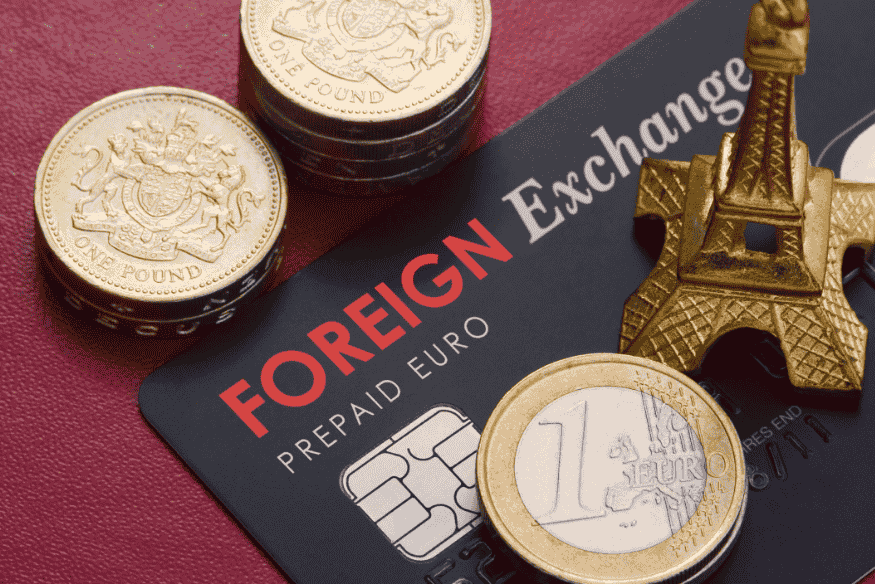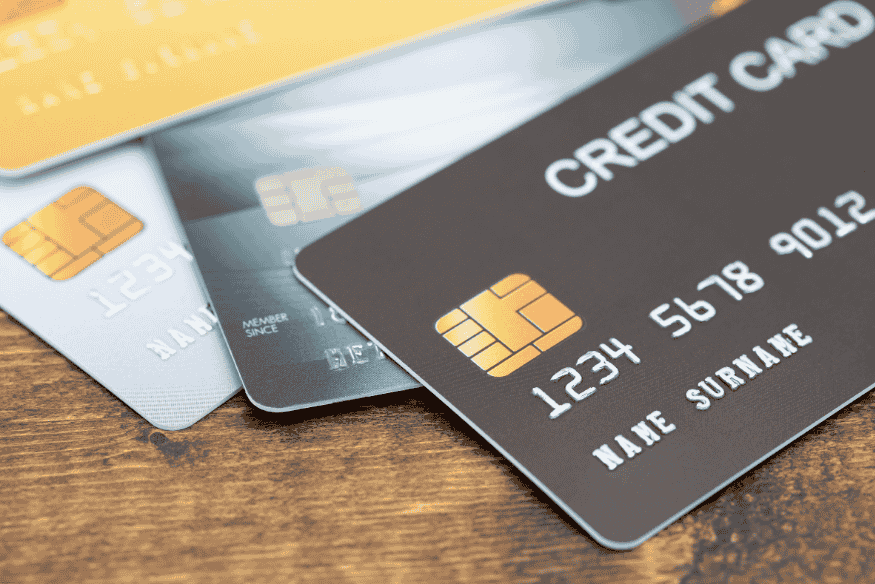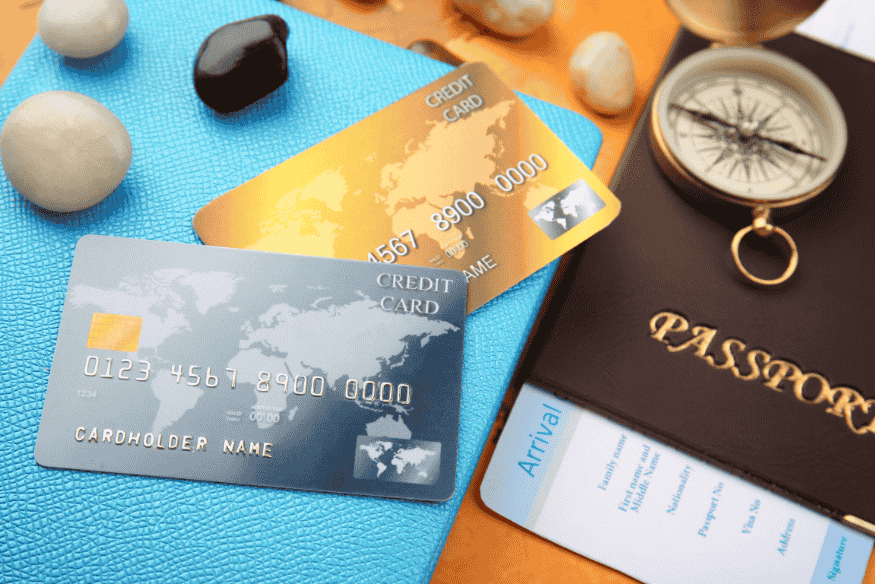Traveling abroad, whether for fun or work, means you need to manage your money well. A credit card can be a convenient alternative to carrying cash. It makes spending money overseas easier.
Using your credit card abroad comes with many travel tips and services. For example, credit card travel insurance can give you peace of mind while traveling.
But, it’s key to know the downsides of using your credit card abroad. You might face foreign transaction fees and different exchange rates.
Key Takeaways
- Understand the fees associated with your credit card when traveling abroad.
- Check if your credit card offers travel insurance and what it covers.
- Notify your bank of your travel plans to avoid transaction issues.
- Be aware of the exchange rates and how they affect your purchases.
- Consider using a credit card with no foreign transaction fees.
The Benefits of Using Credit Cards While Traveling Internationally
Traveling abroad can be easier with a credit card. They make spending simple, as you don’t need to carry lots of cash. You also avoid worrying about exchange rates or losing money to theft.
Convenience and Widespread Acceptance
Credit cards are accepted almost everywhere, making them handy for travelers. You can use them to buy things, eat out, or get cash from ATMs. This means you can mostly rely on your credit card, not needing lots of cash.
Better Exchange Rates Than Cash Exchanges
Credit cards often give you better exchange rates than cash. They usually have good rates, and some don’t charge foreign transaction fees. This can save you money when you buy things abroad.
Purchase Protection and Fraud Security
Using credit cards abroad also means you get extra protection. If your card is lost or stolen, you can quickly get it replaced. Plus, credit cards often protect your purchases, refunding or replacing items that get lost, stolen, or damaged.
Understanding Foreign Transaction Fees

Traveling abroad can be expensive, especially when it comes to credit card fees. Many cards charge extra for purchases made outside your country. This is known as a foreign transaction fee.
What Are Foreign Transaction Fees?
These fees are added to your bill when you buy something in a foreign currency. They’re a percentage of the total cost. This means you pay more than you should for your purchases.
How Much Can These Fees Cost You?
The cost of foreign transaction fees varies. They can be between 2% and 5% of the purchase. For example, a €1,000 purchase with a 3% fee adds €30 to your bill. This can quickly add up.
Cards That Waive Foreign Transaction Fees
But, there’s good news. Some credit cards don’t charge these fees. Cards like the Chase Sapphire Preferred and Capital One Venture are great for travelers. They let you shop abroad without extra fees.
| Credit Card | Foreign Transaction Fee | Annual Fee |
|---|---|---|
| Chase Sapphire Preferred | None | $95 |
| Capital One Venture | None | $95 |
| Citi Prestige | None | $495 |
Choosing a card without foreign transaction fees can save you money. Always check your card’s details to avoid unexpected fees.
Currency Conversion Charges: Dynamic Currency Conversion (DCC)
Paying in your home currency abroad might seem easy, but it can cost more. This is called Dynamic Currency Conversion (DCC). Knowing about DCC can help you make smarter choices when traveling.
What Is Dynamic Currency Conversion?
Dynamic Currency Conversion lets you pay with your home currency in foreign countries. It might seem handy, but you usually get worse exchange rates than if you paid in local currency.
Why You Should Almost Always Decline DCC
Choosing not to use DCC is usually best. It means you pay in local currency, which often has better rates. This way, you also skip extra DCC fees.
How to Ensure You’re Charged in Local Currency
To dodge DCC, just say no when asked. Some places might not show DCC clearly. Always check your receipt to make sure you paid in local currency.
| Currency | Exchange Rate with DCC | Exchange Rate without DCC |
|---|---|---|
| EUR | 1 USD = 0.85 EUR | 1 USD = 0.88 EUR |
| GBP | 1 USD = 0.75 GBP | 1 USD = 0.78 GBP |
By avoiding DCC, you can save on international deals. Always choose to pay in local currency for better rates.
Notifying Your Bank Before Travel
Before you travel abroad, don’t forget to tell your bank. This simple step can greatly improve your trip. It stops your card from being blocked for suspicious activity.
Why Travel Notifications Are Important
Travel notifications are key. They let your bank know you’re traveling. This way, your card is less likely to be flagged for fraud.
This can save you from the hassle of your card being declined while you’re away.
How to Set Travel Notices for Finnish Banks
Finnish banks make it easy to set travel notices. Just use their online banking or mobile apps. Log in, go to settings or notifications, and add your travel plans.
What Information to Provide
When you set a travel notice, you’ll need to give some details. You’ll have to list where you’re going and when. Some banks might ask about your trip’s purpose or other info.
| Bank | Method to Set Notice | Required Information |
|---|---|---|
| Nordea | Online Banking/Mobile App | Destination, Dates |
| Danske Bank | Online Banking/Mobile App | Destination, Dates, Purpose |
| OP | Online Banking/Mobile App | Destination, Dates |
By telling your bank before you travel, you’ll have a better, safer experience with your credit card abroad.
Security Precautions When Using Credit Cards Abroad
Traveling internationally means keeping your credit card details safe is crucial. You need to take some basic steps and know how to handle your card transactions. This will help protect your finances while you’re away.
Keeping Your Card Information Safe
Always be careful with your card. Consider storing one card in the hotel safe and keeping another with you. If you think someone might have accessed your card, block it in your bank’s app.
Monitoring Your Accounts While Traveling
Check your account statements and transaction history often. Look for anything odd. Many banks have mobile apps that let you watch your accounts live, adding extra security.
What to Do If Your Card Is Lost or Stolen
If your card goes missing, tell your bank right away. Credit card companies have 24/7 help lines for emergencies. You can also report it through their app.
Using Secure ATMs and Payment Terminals
Make sure ATMs and payment terminals are safe and not tampered with. Choose ATMs in bright, busy spots. Avoid standalone ATMs in quiet places.
Best Practices for Using Credit Cards in Different Regions

Credit card use changes a lot from one place to another. Knowing these differences can make your travels better. It helps avoid problems with money.
Europe and Chip-and-PIN Requirements
In Europe, Chip-and-PIN is the usual way to pay with cards. Many places don’t use magnetic stripe cards anymore. Make sure your card works with Chip-and-PIN to avoid trouble.
North America and Magnetic Stripe Prevalence
In North America, magnetic stripes are still common. Even if your card has a chip, you might still use the magnetic stripe. But, some places might only take chip payments, which is getting rarer.
Asia and Mobile Payment Adoption
Asia is leading in using mobile payments. Countries like China and South Korea use apps like Alipay and WeChat Pay a lot. It’s smart to have a mobile payment option or cash ready.
Developing Countries and Cash Dependence
In some developing countries, cash is the main way to pay. Even in big cities, credit cards might not be accepted. It’s best to carry both credit cards and local money.
| Region | Primary Payment Method | Recommended Preparation |
|---|---|---|
| Europe | Chip-and-PIN | Ensure your card is Chip-and-PIN enabled |
| North America | Magnetic Stripe | Have a card with a magnetic stripe |
| Asia | Mobile Payments | Consider using mobile payment methods |
| Developing Countries | Cash | Carry local currency and credit cards |
Using Credit Cards Abroad: Essential Tips for Finnish Travelers
Traveling abroad as a Finn means you’ll face different payment systems. Knowing how to use your credit cards can greatly improve your trip.
Top Finnish Credit Cards for International Travel
Some Finnish credit cards are better for international travel. For example, Nordea’s Gold card offers great travel insurance and protection. Look for cards that don’t charge foreign transaction fees and have good travel insurance.
Navigating EU vs. Non-EU Payment Systems
In the EU, payment systems are mostly the same. But, non-EU countries have different systems, like chip-and-PIN or mobile payments. Make sure your credit card is widely accepted.
| Payment System | EU Countries | Non-EU Countries |
|---|---|---|
| Chip-and-PIN | Widely accepted | Varies by country |
| Mobile Payments | Increasingly popular | Gaining traction |
| Magnetic Stripe | Less common | Still widely used |
Finnish Bank Policies and Support While Traveling
Before you travel, tell your bank about your plans. This way, they won’t flag your transactions as suspicious. Finnish banks like Nordea offer help, including emergency card services and 24/7 support.
Currency Considerations for Finnish Travelers
When traveling outside the EU, remember the local currency and exchange rates. Use a credit card with no foreign transaction fees to save money. Also, use ATMs affiliated with your bank to avoid high withdrawal fees.
By being informed and choosing the right credit cards, you can have a smoother, more secure trip.
Maximizing Travel Rewards and Benefits
To make the most of your travels, it’s key to know how to use your credit card benefits. By choosing the right credit card rewards and benefits, you can improve your travel experience. You might even save some money.
Travel-Specific Credit Card Rewards
Some credit cards have travel-specific rewards. These can be points or miles for flights, hotel stays, or other travel costs. These rewards are great for those who travel a lot. For example, some cards give extra points for booking travel through certain portals or with specific airlines.
Earning Points on International Purchases
Earning points on purchases made abroad is another smart move. Many cards give points or cashback on all purchases, at home or abroad. Look for cards with no foreign transaction fees to avoid extra charges.
Travel Insurance and Other Card Benefits
Many credit cards also offer travel insurance and other benefits. These can include trip cancellation insurance, travel medical insurance, and help with lost or stolen luggage. Make sure to check what benefits your card offers.
Alternative Payment Methods to Complement Your Credit Cards
Traveling abroad means you need different ways to pay. Credit cards are common, but other methods offer more convenience and safety.
Mobile Payment Solutions
Apple Pay and Google Pay are great for international spending. They let you pay with your phone, adding extra security like biometric checks.
Prepaid Travel Cards
Prepaid travel cards are good for keeping your spending in check. They hold many currencies, helping you budget better. Plus, they often have better rates and lower fees than credit cards.
When Cash Is Still Necessary
Even with digital payments, cash is still needed sometimes. Local shops or markets might not take cards or mobile payments. It’s wise to carry some local cash.
| Payment Method | Benefits | Limitations |
|---|---|---|
| Mobile Payments | Convenient, secure, widely accepted | Dependent on technology, not universally accepted |
| Prepaid Travel Cards | Budget-friendly, competitive exchange rates | May have loading limits, not all merchants accept prepaid cards |
| Cash | Universally accepted, no transaction fees | Risk of loss or theft, exchange rate variations |
Handling Emergency Situations While Abroad

Having your credit card declined while traveling abroad can be really frustrating. It’s important to know how to handle these emergencies. This way, you can keep your travel plans on track without too much stress.
What to Do If Your Card Is Declined
If your card is declined, the first thing to do is call your bank’s customer service. They can tell you if there’s a problem with your card or if there’s a security hold. Make sure you have their contact info ready to solve the issue fast.
Emergency Card Replacement Services
Many banks offer emergency card replacement for travelers. This service can be a big help if your card is lost, stolen, or damaged. Check with your bank to see if they offer this service and understand how to request a replacement.
Accessing Emergency Funds
It’s key to have access to emergency funds while traveling. Consider carrying a backup credit card or having some cash on hand. Some banks also let you access emergency cash through their network abroad.
| Bank | Emergency Card Replacement | Emergency Cash Access |
|---|---|---|
| Nordea | Yes | Yes |
| Danske Bank | Yes | No |
| OP Bank | Yes | Yes |
Conclusion: Smart Credit Card Usage Makes for Smoother Travel
Understanding how to use credit cards abroad can make your travel smoother. As a Finnish traveler, knowing about credit card usage is key for a hassle-free trip.
First, pick the right credit card for international travel. Always tell your bank you’re traveling. Also, watch out for foreign transaction fees. Consider using mobile payments too. For more tips on managing your credit cards abroad, check out NerdWallet’s guide.
Being smart with your credit card can make your travels easy. Whether you’re exploring the EU or non-EU countries, being prepared is crucial. It ensures you enjoy your trip to the fullest.









